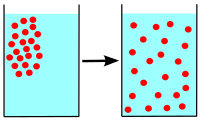
Photo from wikipedia
Injecting carbon dioxide to enhance shale gas recovery (CO 2 -EGR) is a useful technique that has raised great research interests. Clear understanding of the two-component gas transport mechanisms in… Click to show full abstract
Injecting carbon dioxide to enhance shale gas recovery (CO 2 -EGR) is a useful technique that has raised great research interests. Clear understanding of the two-component gas transport mechanisms in shale nanopores is the foundation for the efficient development of shale gas reservoir (SGR) and also the long-term geological storage of CO 2 . Although extensive studies on single-component gas transport and corresponding models in shale nanopores have been carried out in recent years, limited studies have been conducted on two-component or even multi-component gas transport models in shale nanopores. In this work, the shale nanopores were classified into inorganic and organic nanopores. The corresponding models for two-component gas transport were constructed. Mechanisms including Knudsen diffusion, slip flow, viscous flow, and molecular diffusion are considered in the inorganic pores. In the organic pores, due to existence of adsorption gas, surface diffusion is further considered besides the aforementioned mechanisms. Effects of pressure, temperature, fraction of organic nanopores, and gas concentration were analyzed. Results show that gas apparent permeability is negatively correlated with pressure, and positively correlated with temperature and organic nanopore fraction. As the concentration of CH 4 decreases, the apparent permeability of CH 4 increases continuously, while the apparent permeability of CO 2 decreases. The permeability ratio of CH 4 in the total permeability is negatively correlated with pressure and gas concentration ratio. Additionally, the contribution of transport mechanisms to the total gas apparent permeability has been analyzed. It is found that the surface diffusion contributes up to 5.68% to gas apparent permeability under high pressure. The contribution of molecular diffusion can reach up to 88.83% in mesopores under low pressure. Under high pressure and macropores, it contributes less than 1.41%. For all situations, the contribution of viscous flow is more than 46.36%, and its contribution can reach up to 86.07%. Results of this study not only can improve the understanding of two-component gas transport in nanochannels, but also can lay the foundation for more reliable reservoir simulation of CO 2 -EGR.
Journal Title: Energies
Year Published: 2020
Link to full text (if available)
Share on Social Media: Sign Up to like & get
recommendations!